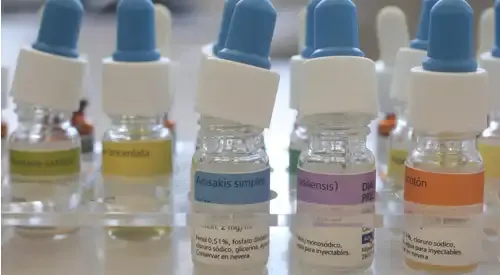Fungal Allergy
"The treatment of fungal allergy at the Clinica is focused on immunotherapy, although pharmacological treatment is also prescribed depending on the severity of the disease".
DR. CARMEN D'AMELIO
SPECIALIST. ALLERGY AND IMMUNOLOGY DEPARTMENT

How do I know if I have a fungal allergy?
Fungi are little talked about allergens, yet they are highly allergenic, affect mostly children and are not easily eliminated.
The main genera of fungi that cause allergy are Alternaria, Aspergillus, Cladosporium and Penicillium.
Fungal spores are found in the air in much higher concentrations than pollens and in many cases are smaller than the pollen grains, thus they can more easily reach the lower respiratory tract and cause asthma.
They are present in the atmosphere throughout the year, but begin to concentrate in higher quantities in the spring months and very high in the summer. Unlike pollen, fungus spores increase or decrease when certain climatic conditions are present.
The factors that favor the growth of the fungi are the humidity, the darkness and the accumulation of dust and organic materials.

What are the symptoms of fungus allergy?
Most patients allergic to these fungi present symptoms in a perennial way, although the maximum concentration of Alternaria spores in the environment occurs during the summer months and, therefore, the peak of symptoms of these patients as well.
The most frequent symptoms are sneezing, tearing, coughing, itchy eyes, nose and throat, reddened eyes, rhinorrhea, thoracic noises (whistles or wheezes), breathing difficulty, etc.
The most common symptoms are:
- Itchy nose and eyes
- Nasal discharge
- Sneezing
- Dry Cough
- Difficulty in breathing
Do you have any of these symptoms?
You may have an allergy to mold.
How is fungal allergy diagnosed?

The diagnosis of mold allergy can be difficult to make, since the commercial extracts available so far for diagnostic procedures are not very effective.
The original sensitizing source of the fungi (mycelium, spores or their metabolites) is not defined, so it is not clear how the extracts with antigenic activity should be produced or the most appropriate methods for their standardization.
In addition, there is a great antigenic variability in the fungal strains.
For all this, immediate hypersensitivity to fungi has important difficulties in diagnosis and even more in specific treatment by immunotherapy.
How is mold allergy treated?
Our Immunotherapy Unit is formed by doctors and nurses with great experience in this treatment
The treatment of patients with respiratory pathology produced by allergy to fungi, as well as that caused by other aeroallergens, is based on three fundamental pillars that complement each other:
- Preventive measures. The first measure is to prevent patients from having contact with fungal spores.
- Pharmacological treatment. They can be divided into anti-inflammatory drugs (corticoids, chromones and anti-leukotrienes) and bronchodilators. The indication of one or another of these drugs will depend on the severity of the disease.
- Immunotherapy. It is currently the only treatment for the cause of respiratory allergic diseases mediated by specific IgE antibodies.
Immunotherapy consists of repeated injections of minimal doses of the allergen over a period of 3 to 5 years. After that time, the vaccine achieves in a high percentage of people that our organism stops recognizing that substance as harmful and, therefore, the allergic reaction does not take place. Since there is a risk of allergic reaction, although it is less than 5%, it is administered in the Immunotherapy Units, which are formed by medical and nursing personnel who have sufficient experience to handle these treatments.
At the present time we have a new route for immunotherapy, especially useful in children, which consists of applying drops under the tongue. This avoids punctures and can be applied at home. For a correct prescription of an immunotherapy it is essential to go to the allergist.
Where do we treat it?
IN NAVARRE AND MADRID
Department of Allergology
of the Clínica Universidad de Navarra
The Department of Allergy and Immunology of the Clinic is part of the Global Allergy and Asthma European Network, composed of the 25 best departments of Allergy in Europe, chosen for their scientific excellence, multidisciplinary work, teaching and international activities.
We have the most advanced diagnostic techniques, we are at the forefront of research and we collaborate with the best experts. We have more than 50 years of experience in the field.
What diseases do we treat?

Why at the Clinica?
- More than 50 years of experience.
- Pioneers in the technique of molecular diagnosis by microarray.
- Nursing specialized in allergic diseases and their care.








